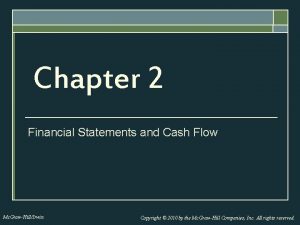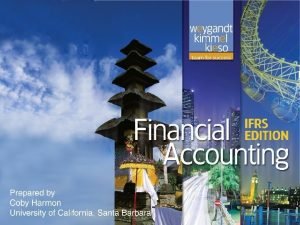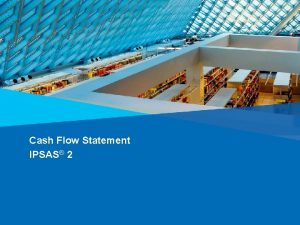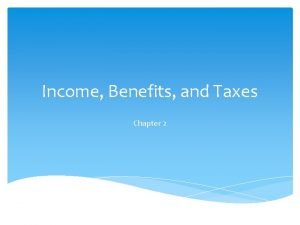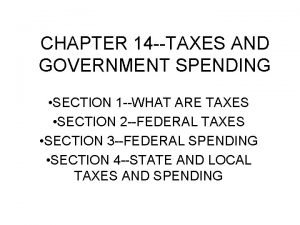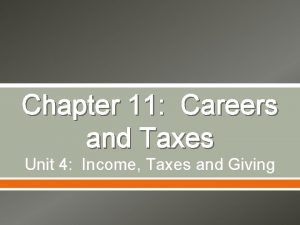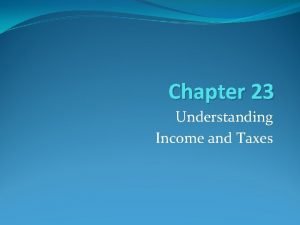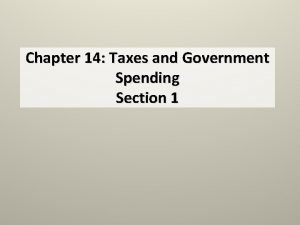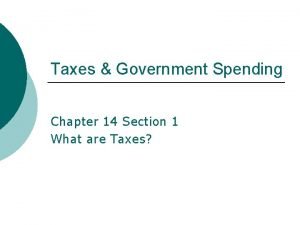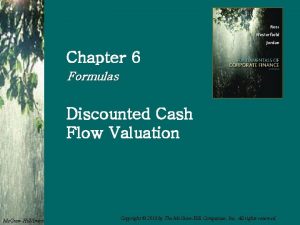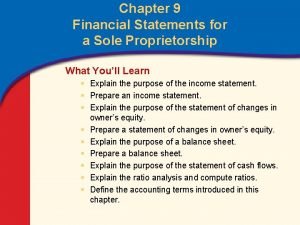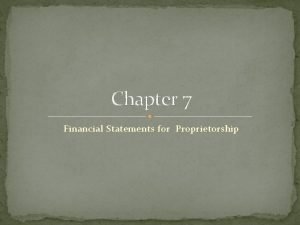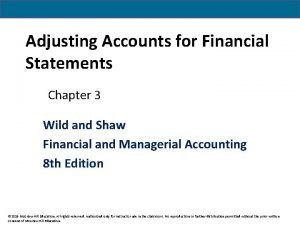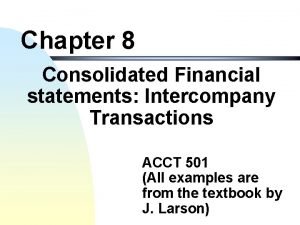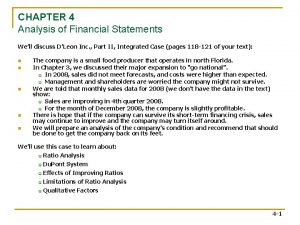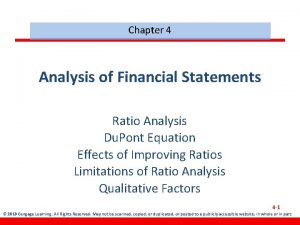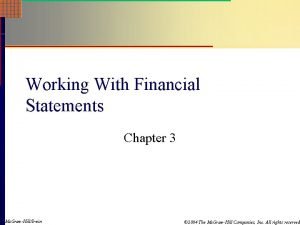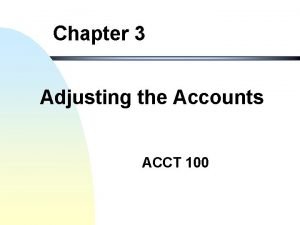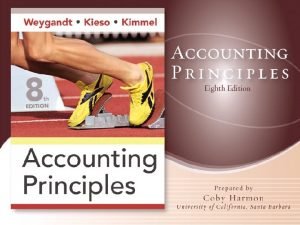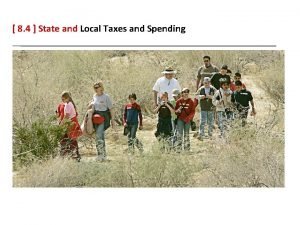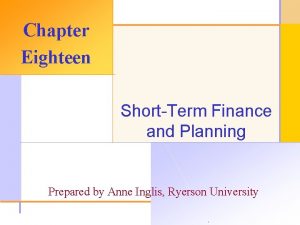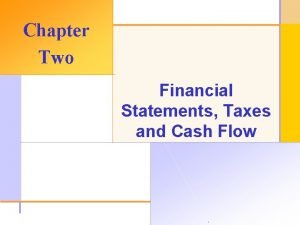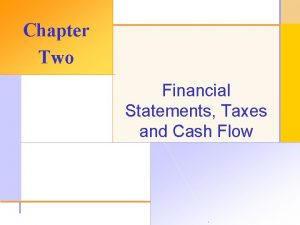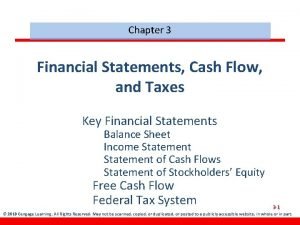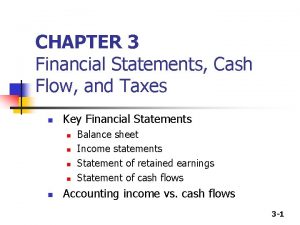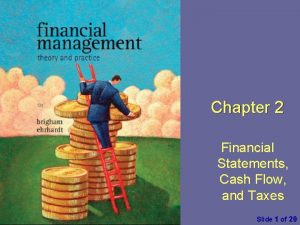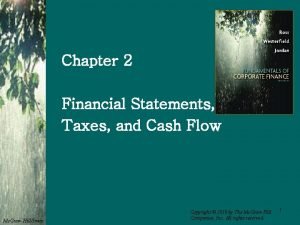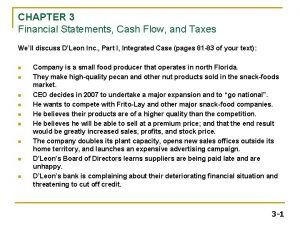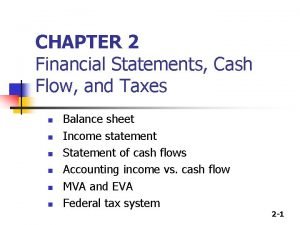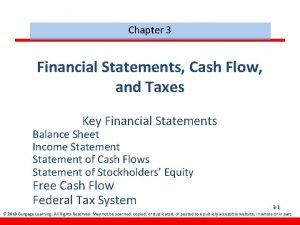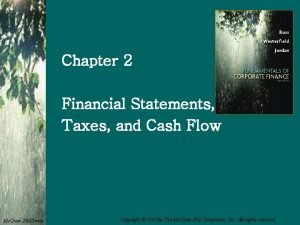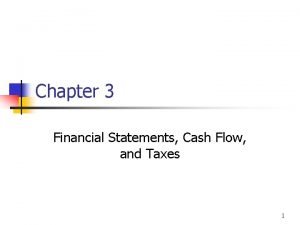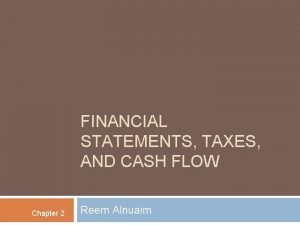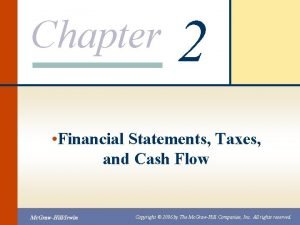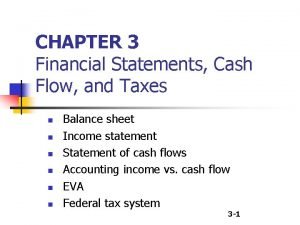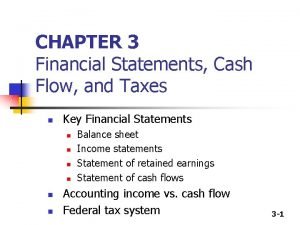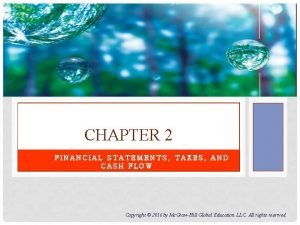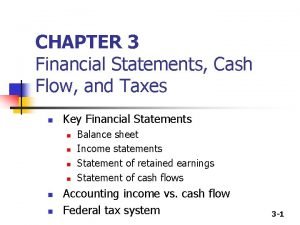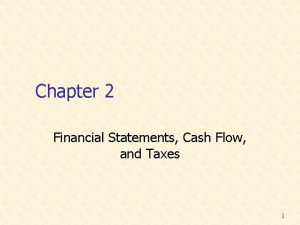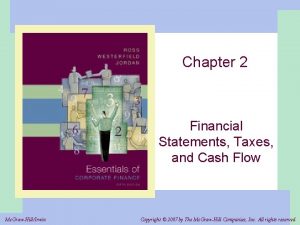Chapter Two Financial Statements Taxes and Cash Flow



























- Slides: 27

Chapter Two Financial Statements, Taxes and Cash Flow © 2003 The Mc. Graw-Hill Companies, Inc. All rights reserved.

2. 1 Key Concepts and Skills • Know the difference between book value and market value • Know the difference between accounting income and cash flow • Know the difference between average and marginal tax rates • Know how to determine a firm’s cash flow from its financial statements Copyright © 2005 Mc. Graw-Hill Ryerson Limited. All rights reserved.

2. 2 Chapter Outline • • • The Balance Sheet The Income Statement Cash Flow Taxes Capital Cost Allowance Summary and Conclusions Copyright © 2005 Mc. Graw-Hill Ryerson Limited. All rights reserved.

2. 3 Balance Sheet - 2. 1 • The balance sheet is a snapshot of the firm’s assets (owns) and liabilities (owes) at a given point in time • Assets are listed in order of liquidity – Ease of conversion to cash – Without significant loss of value (! we can convert anything to cash quickly if we are willing to lower the price enough, but that doesn’t mean it is liquid). • Balance Sheet Identity – Assets = Liabilities + Stockholders’ Equity Copyright © 2005 Mc. Graw-Hill Ryerson Limited. All rights reserved.

2. 4 The Balance Sheet - Figure 2. 1 Copyright © 2005 Mc. Graw-Hill Ryerson Limited. All rights reserved.

2. 5 Net Working Capital and Liquidity • Net Working Capital – Current Assets – Current Liabilities – Positive when the cash that will be received over the next 12 months exceeds the cash that will be paid out – Usually positive in a healthy firm • Liquidity – Ability to convert to cash quickly without a significant loss in value – Liquid firms are less likely to experience financial distress – However, liquid assets earn a lower return – Tradeoff between liquid and illiquid assets Copyright © 2005 Mc. Graw-Hill Ryerson Limited. All rights reserved.

2. 6 Canadian Enterprises Balance Sheet – Table 2. 1 See 2. 14: Canadian Enterprises Example Copyright © 2005 Mc. Graw-Hill Ryerson Limited. All rights reserved.

2. 7 Market Vs. Book Value • Under Generally Accepted Accounting Principles (GAAP) the balance sheet provides the book value of the assets (at historical costs), liabilities and equity. • Market value is the price at which the assets, liabilities or equity can actually be bought or sold. • Market value and book value are often very different. Why? • Which is more important to the decisionmaking process? Copyright © 2005 Mc. Graw-Hill Ryerson Limited. All rights reserved.

2. 8 Example 2. 2 - Quebec Corporation NWC NFA QUEBEC CORPORATION Balance Sheets Market Value versus Book Value Book Market Assets Liabilities and Shareholders’ Equity $ 400 $ 600 LTD $ 500 700 1, 000 SE 600 1, 100 1, 600 Copyright © 2005 Mc. Graw-Hill Ryerson Limited. All rights reserved.

2. 9 Income Statement - 2. 2 • The income statement is more like a video of the firm’s operations for a specified period of time – “between balance sheets” (IS Equation: Rev-Expenses=Income). • You generally report revenues first and then deduct any expenses for the period • Matching principle – GAAP say to show revenue when it accrues (not necessarily when the cash comes in) and match the expenses required to generate the revenue Copyright © 2005 Mc. Graw-Hill Ryerson Limited. All rights reserved.

2. 10 Canadian Enterprises Income Statement – Table 2. 2 See 2. 14: Canadian Enterprises Example Copyright © 2005 Mc. Graw-Hill Ryerson Limited. All rights reserved.

2. 11 Work the Web Example • Publicly traded companies must file regular reports with the Ontario Securities Commission • These reports are usually filed electronically and can be searched at the SEDAR site • Click on the web surfer, pick a company and see what you can find! Copyright © 2005 Mc. Graw-Hill Ryerson Limited. All rights reserved.

2. 12 The Concept of Cash Flow - 2. 3 • Cash flow is one of the most important pieces of information that a financial manager can derive from financial statements • We will look at how cash is generated from utilizing assets and how it is paid to those that finance the purchase of the assets • A primary reason that accounting income differs from cash flow is that the income statement contains non-cash items (depreciation and deferred taxes are non-cash items, as they don’t involve any cash outflow). Copyright © 2005 Mc. Graw-Hill Ryerson Limited. All rights reserved.

2. 13 Cash Flow From Assets • Cash flow is one of the most important piece of information that can be obtained from financial statements ($in - $out). • Cash flow is the most reliable measure of a borrower’s ability to repay its debts. • Assets = Liabilities + Stockholders’ equity • Cash Flow From Assets (CFFA) = Cash Flow to Bondholders + Cash Flow to Shareholders Copyright © 2005 Mc. Graw-Hill Ryerson Limited. All rights reserved.

2. 14 Cash Flow From Assets • Cash flow from assets involves three components: • Operating cash flow: cash flow resulting from the day-to-day activities. • Capital spending: purchases of fixed assets minus sales of fixed assets. • Additions to net working capital: net amount spent on short-term assets. • Cash Flow From Assets = Operating Cash Flow – Net Capital Spending – Changes in NWC Copyright © 2005 Mc. Graw-Hill Ryerson Limited. All rights reserved.

2. 15 Cash Flow From Assets • Operating Cash Flow • Operating cash flow is revenues minus “cash” costs, which means that depreciation and interest expense (as this is a financing expense and will appear in the cash flow to bondholders) will be excluded. • Note that the exclusion of financing expense contrasts with the accounting definition of operating cash flow. Copyright © 2005 Mc. Graw-Hill Ryerson Limited. All rights reserved.

2. 16 Example: Canadian Enterprises • OCF (I/S) = EBIT + depreciation – taxes = $509 • Net capital spending- NCS (B/S and I/S) = ending net fixed assets – beginning net fixed assets + depreciation = $130 • Changes in NWC (B/S) = ending NWC – beginning NWC = $330 • CFFA = 509 – 130 – 330 = $49 • CF to Creditors (B/S and I/S) = interest paid – net new borrowing (ending LT debt – beginning LT debt) = $24 • CF to Stockholders (B/S and I/S) = dividends paid – net new equity raised (in the capital markets )= $25 • CFFA = 24 + 25 = $49 Copyright © 2005 Mc. Graw-Hill Ryerson Limited. All rights reserved.

2. 17 Cash Flow Summary Table 2. 4 Copyright © 2005 Mc. Graw-Hill Ryerson Limited. All rights reserved.

2. 18 Example: Balance Sheet and Income Statement Information • Current Accounts – 1998: CA = 1500; CL = 1300 – 1999: CA = 2000; CL = 1700 • Fixed Assets and Depreciation – 1998: NFA = 3000; 1999: NFA = 4000 – Depreciation expense = 300 • LT Liabilities and Equity – 1998: LTD = 2200; Common Equity = 500; RE = 500 – 1999: LTD = 2800; Common Equity = 750; RE = 750 • Income Statement Information – EBIT = 2700; Interest Expense = 200; Taxes = 1000; Dividends = 1250 Copyright © 2005 Mc. Graw-Hill Ryerson Limited. All rights reserved.

2. 19 Example: Cash Flows • OCF = 2700 + 300 – 1000 = 2000 • NCS = 4000 – 3000 + 300 = 1300 • Changes in NWC = (2000 – 1700) – (1500 – 1300) = 100 • CF From Assets = 2000 – 1300 – 100 = 600 • CF to Bondholders = 200 – (2800 – 2200) = -400 • CF to Shareholders = 1250 – (750 – 500) = 1000 • CF From Assets = -400 + 1000 = 600 • The CF identity holds. Copyright © 2005 Mc. Graw-Hill Ryerson Limited. All rights reserved.

2. 20 Taxes - 2. 4 • The one thing we can rely on with taxes is that they are always changing • Marginal vs. average tax rates – Marginal – the percentage paid on the next dollar earned – Average – the tax bill / taxable income • Other taxes Copyright © 2005 Mc. Graw-Hill Ryerson Limited. All rights reserved.

2. 21 Capital Cost Allowance (CCA) - 2. 5 • CCA is depreciation for tax purposes • CCA is deducted before taxes and acts as a tax shield • Every capital assets is assigned to a specific asset class by the government • Every asset class is given a depreciation method and rate • Half-year Rule – In the first year, only half of the asset’s cost can be used for CCA purposes Copyright © 2005 Mc. Graw-Hill Ryerson Limited. All rights reserved.

2. 22 Some CCA Classes – Table 2. 8 Copyright © 2005 Mc. Graw-Hill Ryerson Limited. All rights reserved.

2. 23 Example: CCA Calculation • ABC Corporation purchased $100, 000 worth of photocopiers in 2004. Photocopiers fall under asset class 8 with a CCA rate of 20%. How much CCA will be claimed in 2004 and 2005? Copyright © 2005 Mc. Graw-Hill Ryerson Limited. All rights reserved.

2. 24 CCA Example – Solution Beginning Fixed Assets CCA Ending Fixed Assets 2004 50000 (100, 000 x 50%) 10, 000 (50, 000 x 20%) 40000 (50, 000 - 10, 000) 2005 90, 000 (40, 000 + 50, 000) 18, 000 (90, 000 x 20%) 72, 000 (90, 000 - 18, 000) Year Copyright © 2005 Mc. Graw-Hill Ryerson Limited. All rights reserved.

2. 25 Quick Quiz • What is the difference between book value and market value? Which should we use for decision making purposes? • What is the difference between accounting income and cash flow? Which do we need to use when making decisions? • What is the difference between average and marginal tax rates? Which should we use when making financial decisions? • How do we determine a firm’s cash flows? What are the equations and where do we find the information? • What is CCA? How is it calculated? Copyright © 2005 Mc. Graw-Hill Ryerson Limited. All rights reserved.

2. 26 Summary 2. 6 • The balance sheet shows the firm’s accounting value on a particular date. • The income statement summarizes a firm’s performance over a period of time. • Cash flow is the difference between the dollars coming into the firm and the dollars that go out. • Cash flows are measured after-tax. • CCA is depreciation for tax purposes in Canada. Remember the half-year rule. Copyright © 2005 Mc. Graw-Hill Ryerson Limited. All rights reserved.
 Chapter 2 financial statements taxes and cash flow
Chapter 2 financial statements taxes and cash flow Cash flow to creditors is equal to
Cash flow to creditors is equal to Chapter 13 statement of cash flows
Chapter 13 statement of cash flows Ipsas 2
Ipsas 2 Chapter 3 analysis of financial statements
Chapter 3 analysis of financial statements How to improve current ratio
How to improve current ratio Chapter 2 income benefits and taxes
Chapter 2 income benefits and taxes Chapter 14: taxes and government spending section 1
Chapter 14: taxes and government spending section 1 Section 4 best practices of successful people
Section 4 best practices of successful people Chapter 23 understanding income and taxes
Chapter 23 understanding income and taxes Chapter 14 taxes and government spending
Chapter 14 taxes and government spending Chapter 14 taxes and government spending
Chapter 14 taxes and government spending Cash in cash out example
Cash in cash out example Chapter 6 discounted cash flow valuation
Chapter 6 discounted cash flow valuation Chapter 3 adjusting accounts for financial statements
Chapter 3 adjusting accounts for financial statements Sole proprietorship income statement
Sole proprietorship income statement Sole proprietorship financial statements
Sole proprietorship financial statements Adjusting accounts for financial statements chapter 3
Adjusting accounts for financial statements chapter 3 Chapter 8 separate financial statements
Chapter 8 separate financial statements Chapter 4 analysis of financial statements
Chapter 4 analysis of financial statements Chapter 4 analysis of financial statements
Chapter 4 analysis of financial statements Working with financial statements chapter 3
Working with financial statements chapter 3 Adjusting the accounts chapter 3
Adjusting the accounts chapter 3 The time period assumption states that
The time period assumption states that Loss contingency journal entry
Loss contingency journal entry Chapter 19 intermediate accounting
Chapter 19 intermediate accounting State and local taxes and spending
State and local taxes and spending Cash to cash cycle time
Cash to cash cycle time

